Why Is Food Safety Important In Healthcare? Healthcare Leaders Guide
Learn challenges healthcare foodservice teams face today and key food safety practices to protect vulnerable patients. Get a free healthcare leader...
Whole cuts of pork must be cooked to the correct pork internal temperature to ensure food safety.
Pork is a very popular type of meat in the food service industry. There are thousands of dishes built around this main ingredient, as it can be cooked in several ways.
A critical factor in any pork recipe is ensuring that you can reach the recommended pork internal temp for safety. Undercooked pork has the potential risk of causing foodborne illnesses, especially among customers with weakened immune systems.
WHAT WE'LL COVER:
In this section, we will discuss the following topics on pork internal temp:
In general, the minimum recommended pork internal temp for cooking is 145°F (63°C) with a three-minute rest time before carving with a sharp knife. This pork cooking temp is the recommended safe temperature by the U.S. Department of Agriculture (USDA).
The recommended internal temperature of pork was reduced from the original recommendation of 160°F (71°C), provided that the meat will be allowed to rest before carving. The current minimum pork temperature is established to effectively kill pathogenic bacteria while maintaining the desirable qualities of medium-rare pork.
The recommended minimum internal temp for cooking pork of 145°F (63°C) is a general food safety standard. In some cases, this internal pork temp may vary. For example, customers may request well-done pork, and this can be achieved at a proper temperature of 160°F (71°C) or higher.
The best way to ensure a safe internal temperature for pork is to use a properly calibrated thermometer and a visual guide, such as a Meat Temperature Chart.
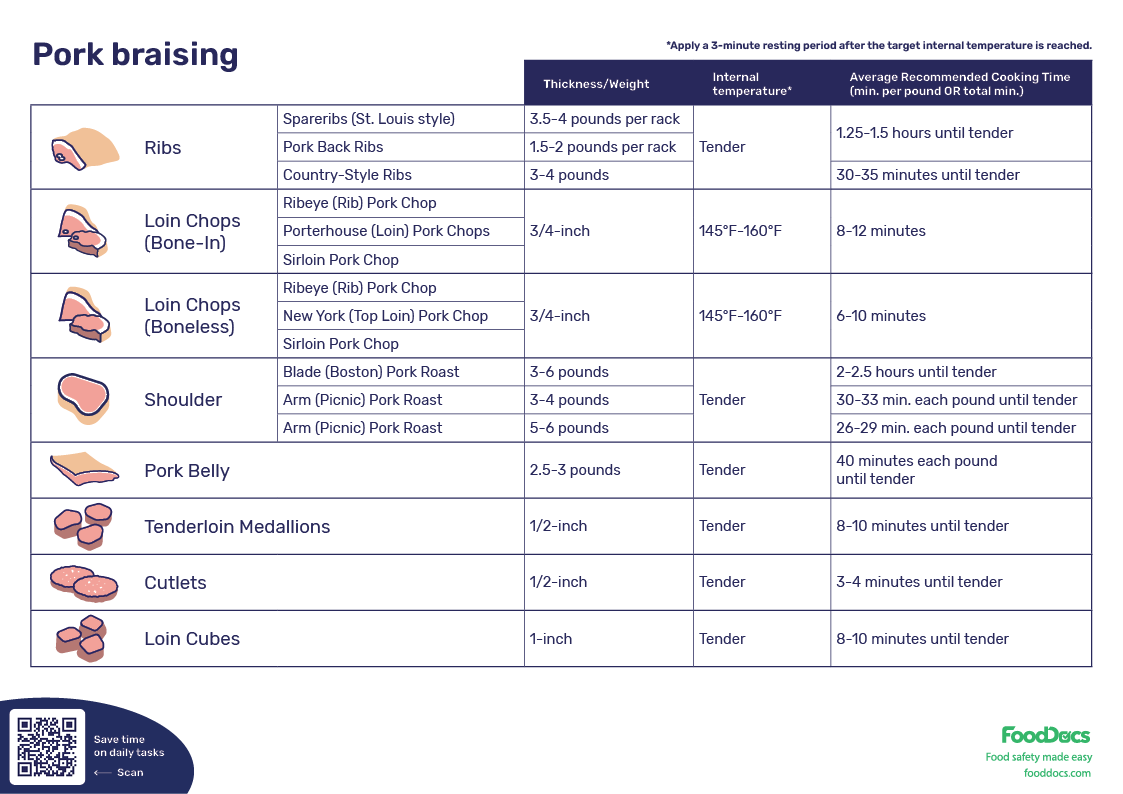

Thank you for downloading free template!
Want to get a customizable HACCP template?
Or set up your food safety system in 15 minutes?
The pork minimum temperature refers to the recommended internal cooking temperature that a cut of pork meat must reach for safety. Food safety agencies established minimum standards for cooking a cut of pork that will most effectively kill pathogens while maintaining desirable qualities.
While the generally recommended pork temp when done is 145°F (63°C), this target may vary in some cases. The minimum temperature may change depending on factors including the following:
For example, the minimum safe temperature for pork shoulder roast is to reach an internal temperature of 160°F (71°C), whereas ham only requires 145°F (63°C).
The minimum done temp for pork is essential to maintain food safety. Failure to cook pork to the target internal temp increases the risk of causing foodborne illness, especially for immunocompromised individuals.
Food handlers must be properly trained on how to use a food thermometer to ensure that pork is accurately cooked all the time.
The key to ensuring that your pork dishes will not cause foodborne illnesses is for your team to monitor handling and cooking tasks consistently. Use a smart Food Safety Management System.
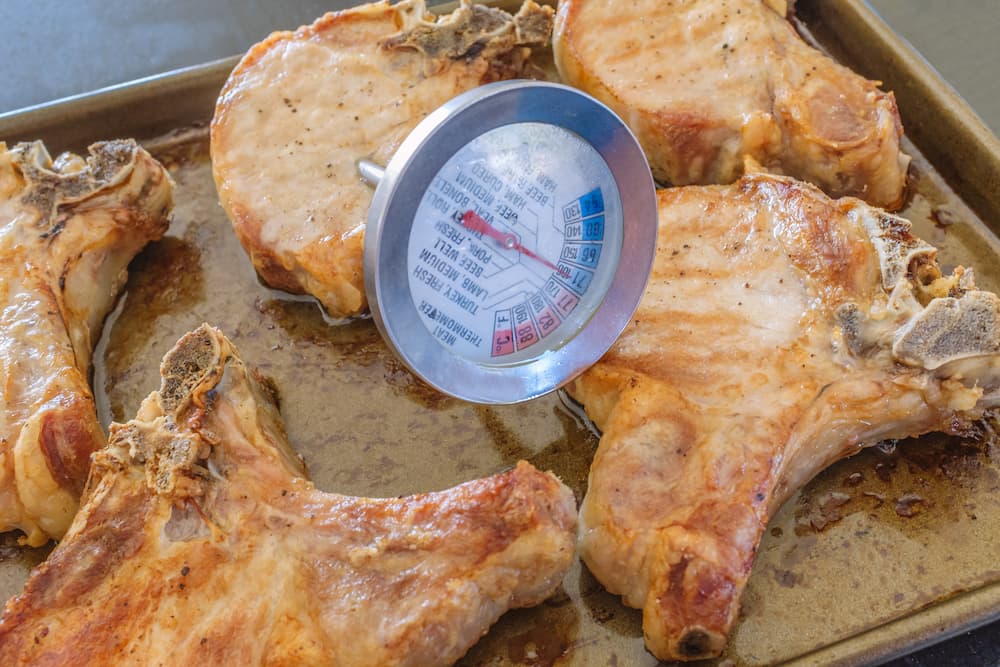
Pork can be cooked well by reaching the internal temperature of 160°F (71°C) with a 3-minute resting time. Alternatively, pork can also be cooked to 170°F (74°C) with no resting time.
Well-done cooking doneness is often recommended for customers who are immunocompromised. This group of customers includes pregnant individuals, the elderly, children under the age of 5, and individuals with immunodeficiencies. This level of doneness ensures that all potentially present harmful bacteria are killed.
Well-done pork has a dark brown exterior crust and no trace of pink meat inside.
Often preferred by most customers, pork can be cooked to an internal temperature of 160°F (71°C) for medium doneness with no resting time. Pork can also be cooked to an internal temperature of 155°F (68°C) with a three-minute rest time.
Medium-cooked pork results in a juicer and more tender texture while maintaining its safety. This level of doneness has a very light pink center with a white outer layer and seared crust. Unlike well-done pork, medium-done pork still has its juiciness and tenderness intact.
Pork is considered a TCS food, meaning time/temperature control for safety food. This means it needs proper controls to maintain safety. Cooking pork to the recommended internal temperature ensures that the target pathogens are destroyed. Pork must be cooked well to protect consumers from foodborne illnesses.
Specifically, the established pork fully cooked temp aims to provide the following benefits:
Cooking pork dishes to the correct internal temperature is part of the responsibility of a food handler. The task helps protect customers from potential foodborne illnesses, such as Trichinosis from pork.
A comprehensive study showed that over 17 years, at least 288 serious outbreaks were caused by consuming undercooked pork. The most commonly associated pathogens in these outbreaks were Staphylococcus aureus and Salmonella, which are common indicators of poor food handling.
Federal agencies, particularly the U.S. Department of Agriculture, have established clear instructions and minimum standards for cooking pork. These standards are based on scientific evidence and consider the desirable qualities of cooked pork.
To help your food handling team ensure that pork dishes are consistently cooked all the time correctly, use FoodDocs' smart Food Safety Management System. Using our smart software, you can get automatically generated monitoring logs that you can use to log temperature readings. Ensure food safety compliance with all regulations with our smart solution.
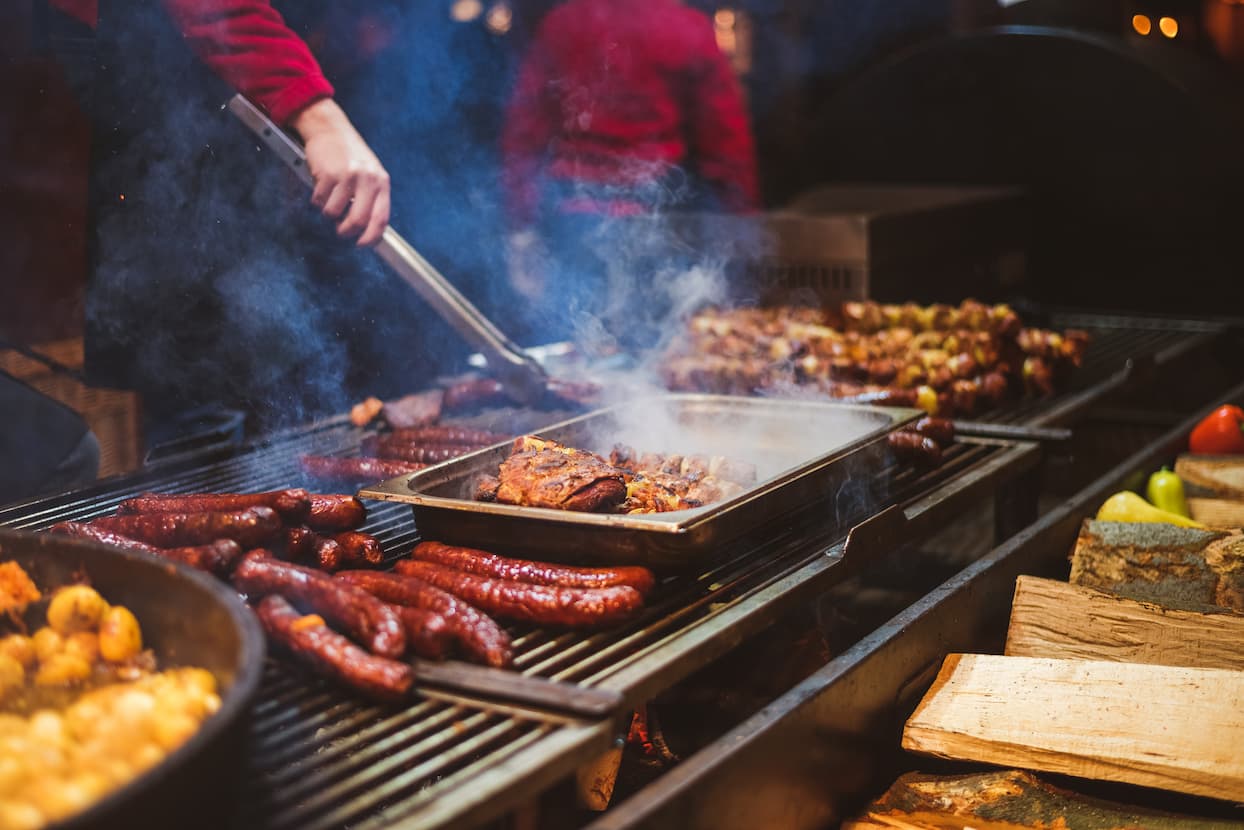
In addition to teaching you how to reach the correct pork cooking temperature, we will also discuss the following:
Reaching the final pork cooked temperature is a critical task to maintain food safety. Food handlers must do this task consistently and without fail. A few degrees off of the target final cooking temperature of pork can increase the risk of food poisoning and parasitic infections.
Follow these two rules to reach the final cooking temperature of pork properly and have a safe eating experience:
These two simple steps must always be followed for any food business handling pork products. Failure to calibrate a meat thermometer can lead to inaccurate temperature readings. In addition, if pork dishes are immediately carved without allowing them to rest, the meat may not be fully cooked, potentially making the dish undercooked.
Grilling is a common cooking method for pork. It can be done over a charcoal grill or a gas grill. This method usually works around 375°F-400°F (190°C-205°C). The target final temperature for pork will depend on the type or cut of pork you are using.
If you are grilling pork loin or chops, an internal temperature of 145°F (63°C) is enough to cook the dish safely. On the other hand, if you are grilling ground pork, then you would need to reach an internal temperature of 160°F (71°C).
Pork cooking chart for grilling
Cooking pork in a frying pan is another popular method for preparing pork dishes. This method can be used to cook different cuts of pork. When using oil for frying, the cooking temperature often reaches around 350°F (177°C).
Using this source of heat, whole cuts of pork must reach an internal temperature of 145°F (63°C) and be allowed to rest after removing from the heat source for 3 minutes. Similar to grilling ground pork, the internal temperature should reach 160°F (71°C).
Pork cooking chart for using a frying pan
Cooking pork in the oven requires the same internal cooking temperature. Oven-roasted or baked pork must be cooked to a final cooking temperature of 145°F (63°C).
Pork cooking chart for using an oven
Smoking uses a slightly different approach. Smoked pork is slowly cooked at a significantly lower temperature, usually around 195°F (91°C). The cut of pork is then allowed to cook for more than two hours, which will break down the connective tissues of the meat.
Different cuts of pork may require different cooking temperatures to achieve the best results in terms of quality and safety.Some pork cuts require higher cooking temperatures because of the number of connective tissues in them, making it hard for heat to reach the center.
In this section, we will discuss the different internal cooking temperatures and cooking time recommendations for the following cuts of pork:
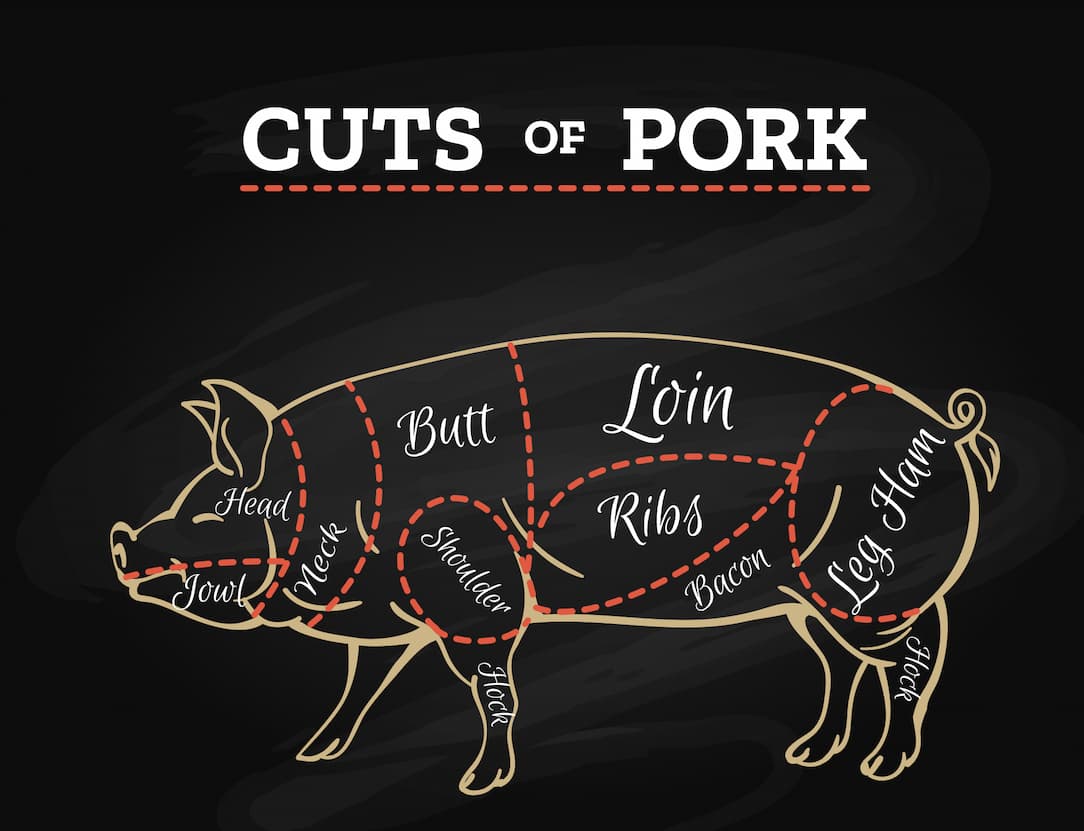
According to the general standard of the USDA, the recommended internal temperature for pork chops is 145°F (63°C).Once the pork chop internal temp is reached, the cuts of pork should be removed from the source of heat. The cooked pork should rest for three minutes before carving or serving.
Pork chops usually take around 15 to 25 minutes of prep time to reach the recommended pork internal temp. The safe temp for pork chops is guaranteed to cook it safely while maintaining its juiciness.
Pork temperature chart for barbecuing
A pork roast is a cut of meat that comes from the section between the shoulder and leg of a pig. Pork roasts are known for having a good fat-to-muscle ratio. The recommended pork roast internal temp is 145°F (63°C) with a three-minute resting time before carving.
Roasts usually come bone-in or boneless. Depending on the thickness of a pork roast, the minimum cooking time to reach the recommended pork roast internal temperature usually takes 30 minutes to an hour.
Pork temperature chart for braising
Pork tenderloin is a cut of pig meat that comes from the backbone area. Tenderloin is often sold as a narrow and long cut of pork, usually around 1-2 inches in thickness, or as tenderloin medallions. The recommended pork tenderloin temperature is 145°F (63°C). Let the pork rest for at least three minutes before serving.
As tenderloin is lean meat and does not come with a bone, it must be carefully cooked to avoid overcooking. Too much heat and the tenderloin will become dry and tough. Cooking a juicy pork tenderloin to the target pork tenderloin internal temp is estimated to take 15-20 minutes.
Pork shoulder is normally cooked at a significantly higher temperature than most recommended ranges. This cut of meat is rich in collagen from the connective tissues attached to the meat.
The internal temp pork shoulder is around 190°F (87°C). This internal temperature is enough to break down the collagen in between the meat and makes the dish safe for consumption.
Because of the thick nature of pork shoulders, the recommended cooking time to reach the target internal temperature is 1 hour to 1 and a half hours.
Pork belly is recommended to be cooked to an internal correct temperature of 165°F (74°C). Similar to shoulders, pork belly is rich in collagen. In addition, pork belly also has a very high-fat content which makes heat harder to reach the core of the meat.
At a pork belly temperature of 165°F (74°C), the meat can be safely consumed without the risk of causing foodborne illnesses while remaining juicy. The average cooking time for each kilo of pork belly is estimated to be around 100 minutes.
Pulled pork is a finished product that is commonly made out of pork shoulders. The required internal temp for pulled pork is the same as the shoulders. To cook pulled pork, shoulders are slowly cooked at 190°F (87°C).
Unlike other pork cuts, pork shoulder must be allowed to rest for at least 30 minutes before it can be pulled apart.
Bone-in pork butt is filled with connective tissues, similar to shoulder cuts. As such, the pork butt done temp is 190°F (87°C) to break down the tissues.
Ground pork requires a consistent internal cooking temperature of 160°F (71°C). According to the USDA, the ground pork internal temp does not require rest time.
Ground pork is a type of processed meat that is passed through a machine to break down the meat and fat. The processing exposes the surface area of the meat to several hazardous factors. As such, all ground meats require cooking to an internal pork temp of 160°F (71°C). Use a digital meat thermometer to measure the temperature accurately.
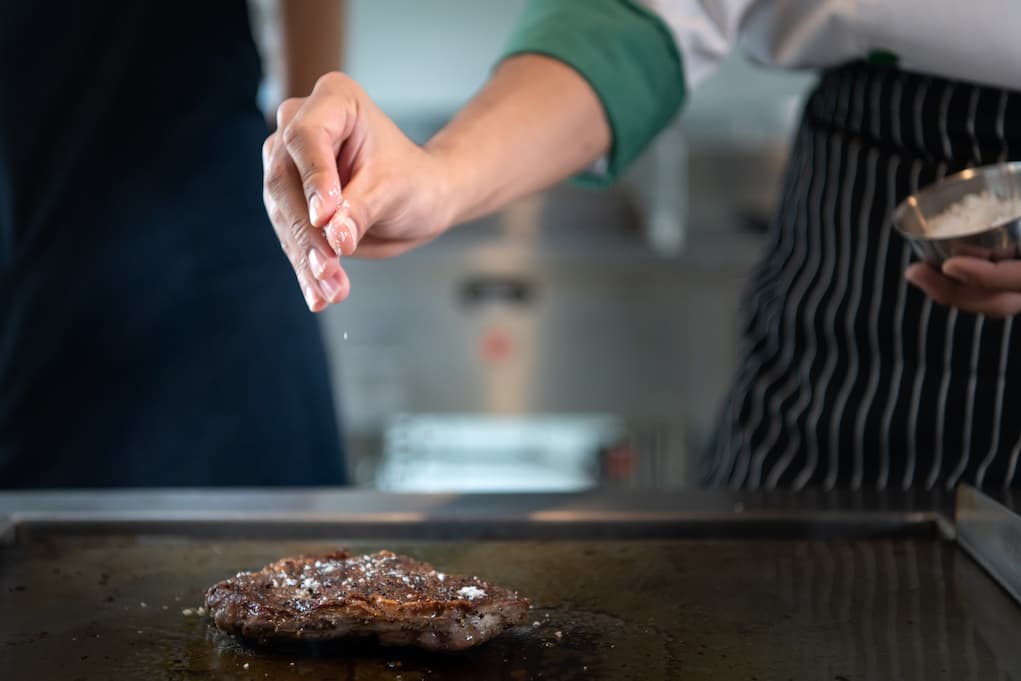
Although the general rule for cooking pork is to reach an internal temperature of 145°F (63°C), some cuts of meat require harsher conditions. Remembering all the recommended internal temperatures and estimated cooking time for each cut of pork may be hard for your employees.
Use our Pork Temperature Charts at FoodDocs! We collected the essential information for the most common pork cuts and presented them in easy-to-use food safety charts. Help your employees remember the correct cooking temperatures and approximate cooking times for each type of pork cut.
Failure to properly cook pork dishes has a lot more consequences beyond just non-compliance with food safety regulations. Below, we listed some of the potential risks of failing to cook pork to the correct pork cooking temperature consistently:
As a food safety manager, you can help prevent these consequences by ensuring that employees will consistently cook pork to the correct internal temperature. Use our smart Food Safety Management System at FoodDocs to make monitoring more efficient and intuitive.
Easily verify if your employees are monitoring the safe temp for pork cooking at a glance with a real-time dashboard. With this feature, you do not need to manage everything on-site. In addition, our system can send smart notifications to responsible employees and remind them to check food temperatures or calibrate the meat thermometer regularly.
There are many considerations when achieving a pork-safe internal cooking temperature. The main objective is that any harmful pathogens must be adequately reduced to safe levels.
Below are some practical tips to accurately achieve a safe internal temp for pork for any food business.
Food employees will need to be properly equipped with training and the right tools to perform all of these tasks correctly. It is important for every food safety manager to train food handlers on how to monitor the safe cooking temperature for pork properly.
Proper cooking is one of the tasks that will need close monitoring to ensure food safety. It must be consistently done every day to ensure that every pork dish that comes out of your food business is safe and will not cause foodborne illnesses.
In addition to close monitoring, your team will also need to properly document every temperature reading as compliance with food safety regulations. Unless you have a whole team dedicated to this task, it may be hard to keep up with regular temperature monitoring.
Using reference and reminder tools such as posters and charts can only support you at a minimum. What you need is a smart and convenient way to monitor your food safety operations.
Use our smart Food Safety Management System at FoodDocs to get the following smart solutions and benefits:
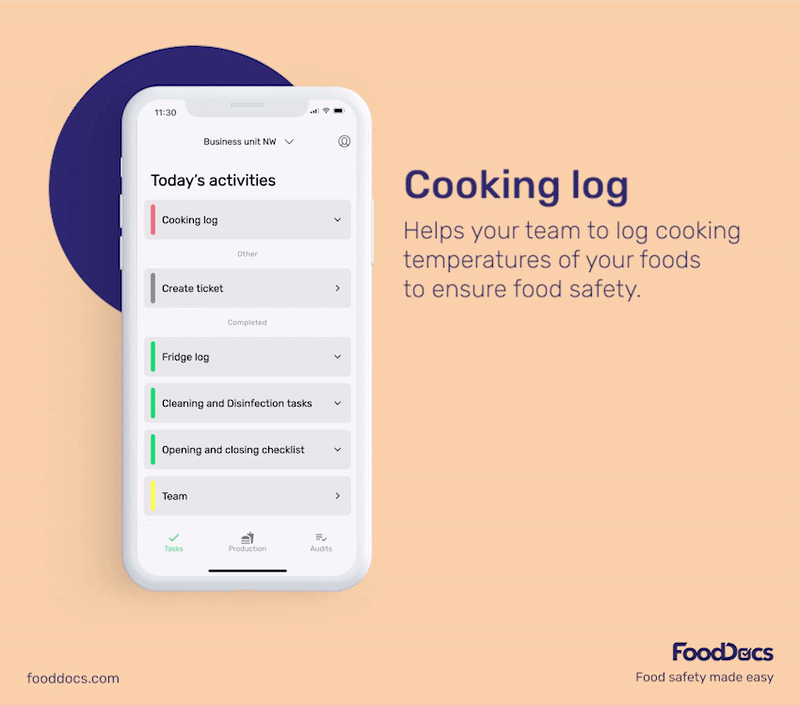
Cooking temperature log from FoodDocs
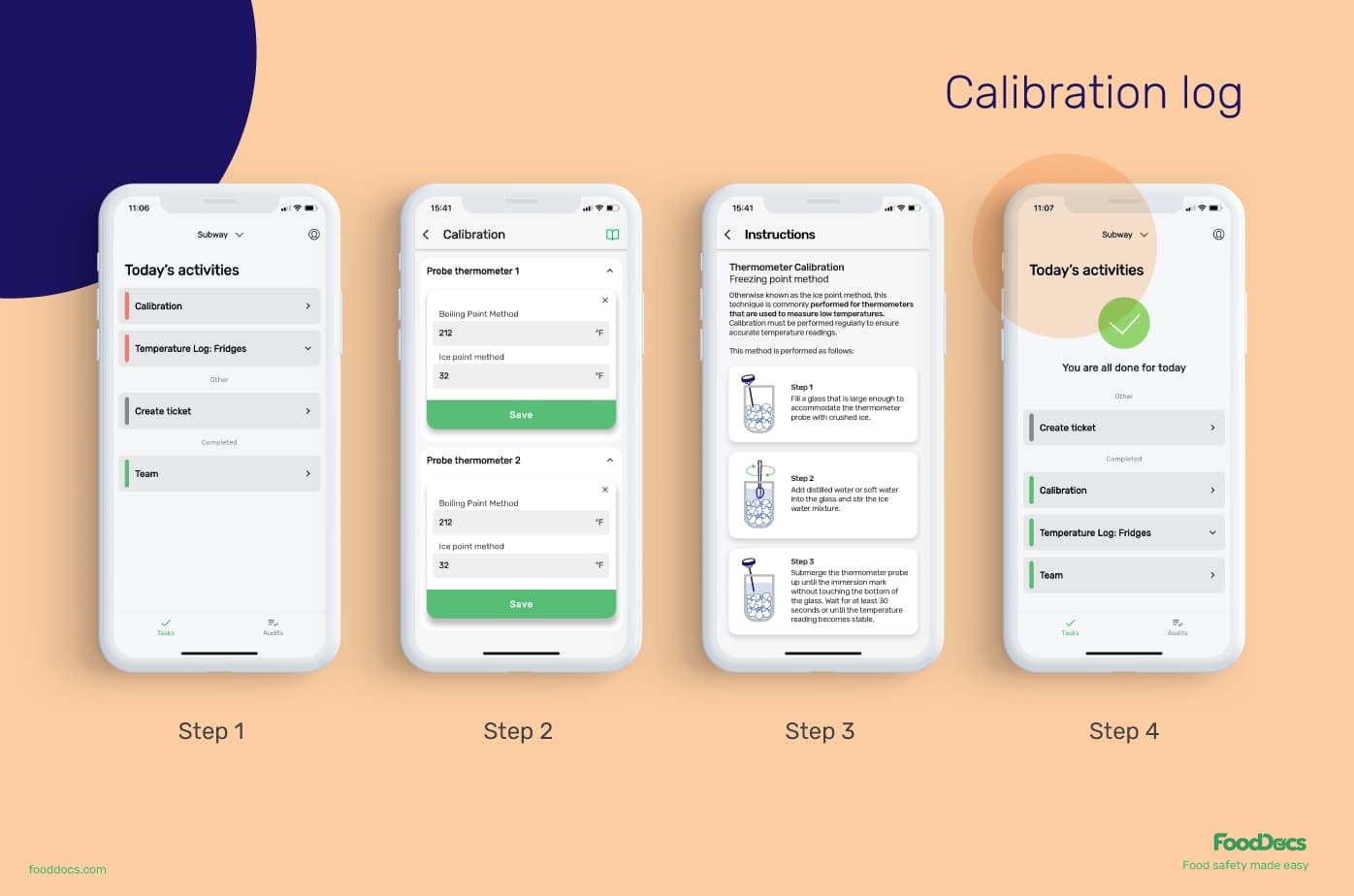
Thermometer calibration log from FoodDocs
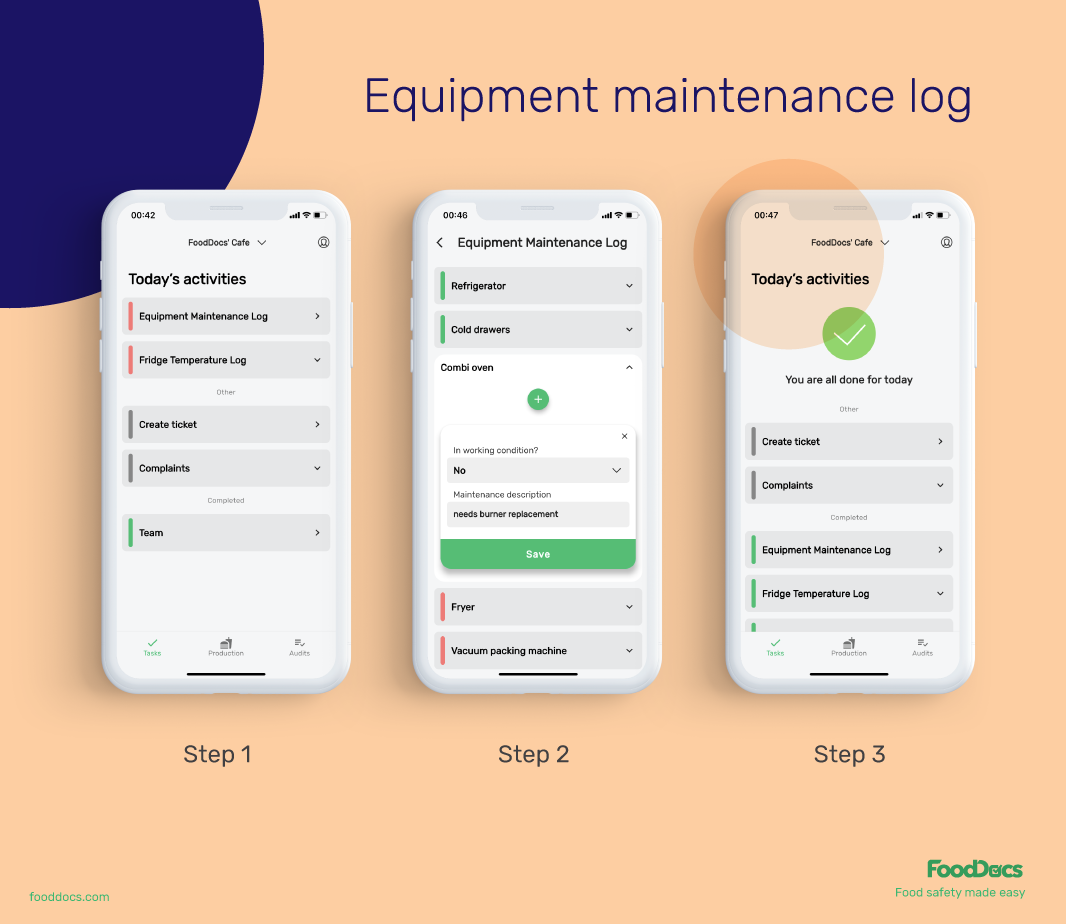
Equipment maintenance log from FoodDocs
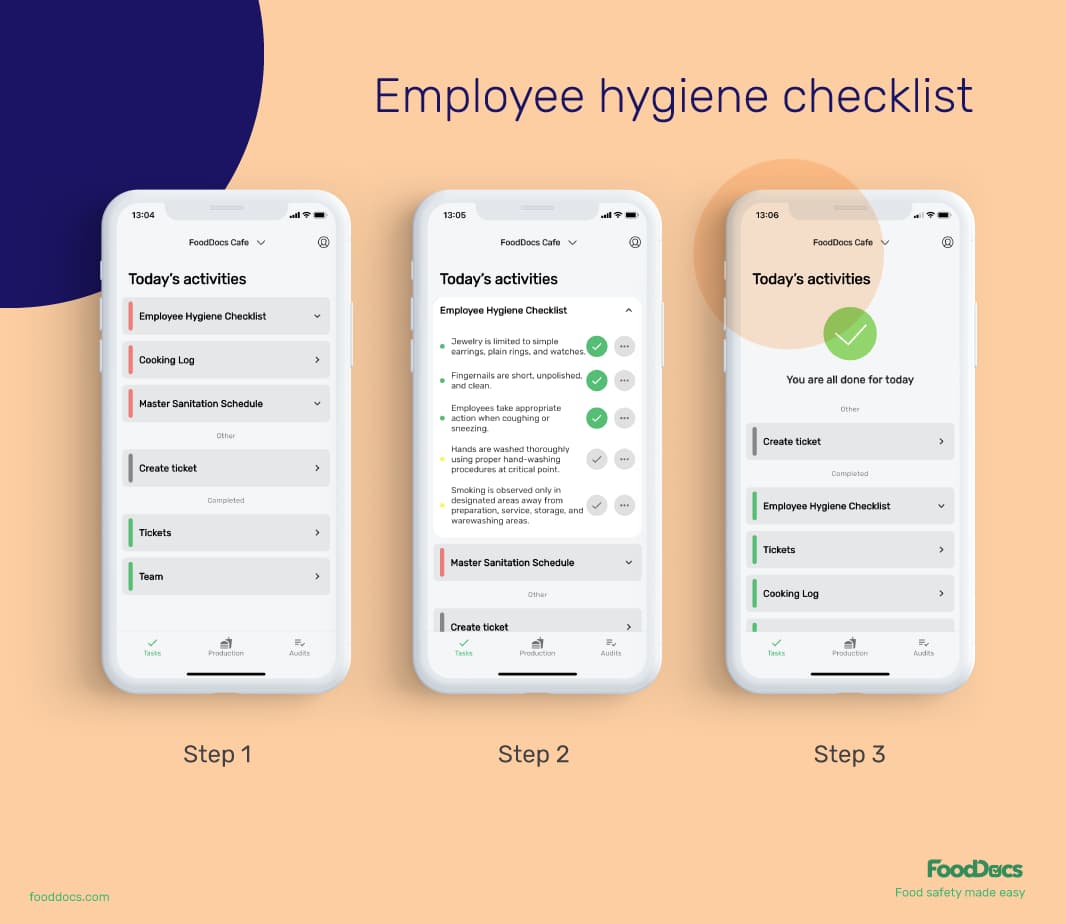
Employee hygiene checklist from FoodDocs
Get more out of our smart software by using our features designed to help managers improve their efficiency.
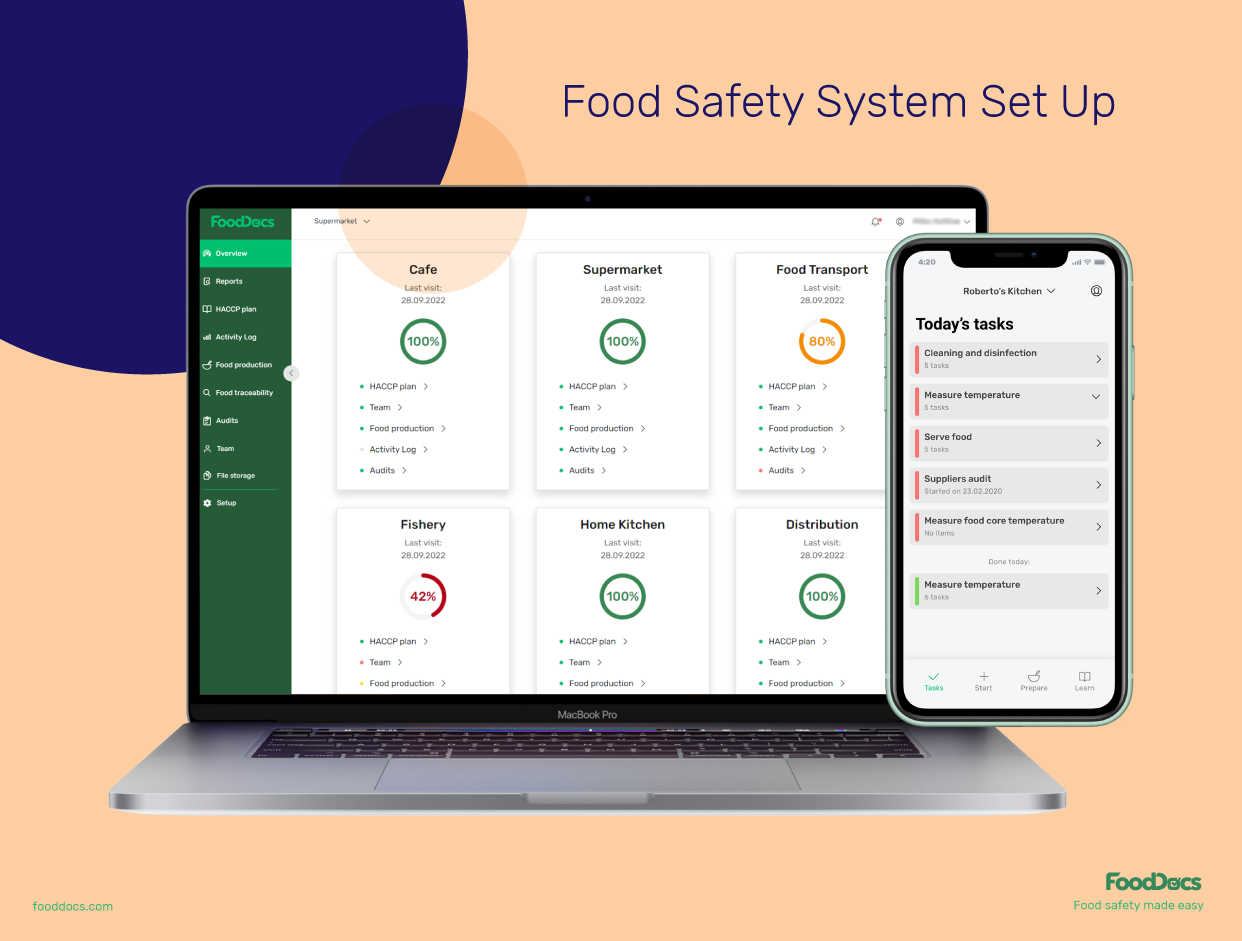
Food Safety System Set Up by FoodDocs
You can get access to all of these features and more in just an average of 15 minutes with our smart Food Safety Management System. Powered by artificial intelligence and a machine-learning program, our system can automatically generate all necessary monitoring logs and documents for you.
In addition to AI-powered solutions, our system can accommodate improvements. You can manually customize monitoring logs, checklists, and other food safety documents from our smart software. Immediately apply suggestions from health inspectors to maintain compliance in just a few seconds.
You can start your digital food safety journey with us by simply using our free 14-day trial. Experience how our smart solutions can improve your working efficiency and maintain food safety compliance.
Do you have more specific questions about cooking pork to the correct internal temperature? Here are some of the most frequently asked questions regarding this topic.
At 145°F (63°C), pork is regarded as safe for consumption. When pork is cooked at this temperature, the meat must be allowed to rest for an additional three minutes. This additional step will allow the residual internal heat to redistribute.
To maintain safety, pork cuts should be cooked to an internal temperature of 145°F (63°C). Use an accurate and properly calibrated thermometer to measure the temperature of pork.
Whole cuts of pork can be cooked to 160°F (71°C) without an additional resting period. In fact, this temperature was the previously recommended internal temp for cooking pork by the USDA. The target temperature was reduced to ensure that the safe pork dish would still be juicy and not overcooked.
Additionally, ground pork is recommended to be cooked at 160°F (71°C).
Yes. Pork is safe to consume at 155°F (68°C). Although higher than the recommended internal temperature, this temperature range will still produce medium doneness.
Consuming pork that is cooked to an internal temperature of 135°F (57°C) significantly increases the risk of getting a foodborne illness. All cuts of pork are recommended to be cooked to at least 145°F (63°C).
Yes, pork that is cooked at 180°F (82°C) is safe to consume. Although, for most cuts of pork, this temperature will produce an overcooked dish. This very high internal temperature is recommended to be used for cuts of pork with very high connective tissues, such as shoulders.
Cooking pork to an internal temperature of 145°F (63°C) will produce medium-rare doneness. This level of doneness is characterized by a bit of pink center with a seared exterior portion.
Ideally, pork ribs must be cooked to an internal temperature range of 190°F to 200°F (88°F to 93°F). Pork ribs have a lot of connective tissues that attach the meat to the bones. These tissues make it hard for the heat to travel to the core of the meat.
Pork sausage is made up of ground pork and a mixture of choice spices. As such, pork sausage is recommended to be cooked to an internal temp of 160°F (71°C) without any rest time.
The pork chop done temp is estimated to be around 145°F (63°C). At this pork chop cook temp, the cut of meat is safe to consume and still juicy.
Similar to other cooking methods, pork chops cooked in an air fryer must reach an internal temperature of 145°F (63°C). To do this, the air fryer is set to 400°F (204°C), and the chops are cooked for about 12 minutes.
The final cook temp for pork roast is estimated to be at around 145°F (63°C). The recommended roast pork temperature is enough to kill pathogens while preventing the meat from going dry.
Not to be mistaken with tenderloin, pork loin must be cooked to an internal temperature of 145°F (63°C).
Because pork ribs are close to the bone and rich in collagen, the estimated internal temperature for pork ribs is 190°F to 200°F (88°F to 93°F).
Pulled pork is made out of pork shoulder, which is rich in collagen. As such, pulled pork is cooked to an internal temperature of 160°F (71°C).
Learn challenges healthcare foodservice teams face today and key food safety practices to protect vulnerable patients. Get a free healthcare leader...
Learn what Standard Operating Procedures (SOPs) are and how to write effective SOPs that ensure consistency, efficiency, and safety in your...
Boost your retail food safety with essential practices and digital tools to protect customers and your brand. Plus a free Retail Food Safety Leader...